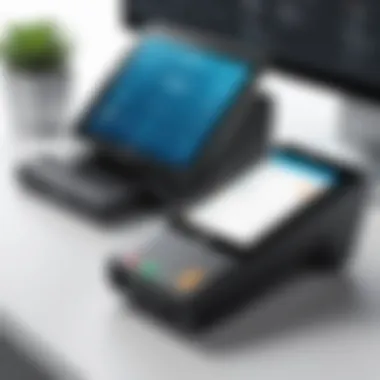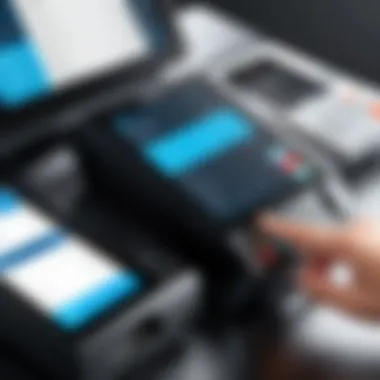Explore the Best POS Software for Your Business


Intro
The landscape of retail and service industries is constantly evolving, and the adoption of advanced technology is crucial. In this context, point of sale (POS) software stands as a vital component for businesses. A robust POS system can streamline operations, manage inventory, and enhance customer experiences. As technology advances, businesses need to stay informed about the available options in the market. This article offers a deep dive into the top POS software solutions, helping decision-makers choose systems that meet their specific operational requirements.
Key Features
Overview of Features
The best POS software comes equipped with a variety of features designed to facilitate day-to-day business activities. Key functionalities often include:
- Sales processing: The primary purpose of a POS system is to facilitate transactions. A good system should allow for fast and efficient sales processing for enhanced customer satisfaction.
- Inventory management: Effective inventory tracking and management are crucial. The software should enable businesses to monitor stock levels, track orders, and manage suppliers seamlessly.
- Employee management: Features that help schedule shifts, manage payroll, and track employee performance are valuable. This assists businesses in optimizing workforce productivity.
- Customer relationship management: A POS system can gather customer data to allow businesses to personalize experiences. This includes tracking purchasing behavior and managing loyalty programs.
- Reporting and analytics: Advanced reporting tools provide insights into sales trends, employee performance, and inventory turnover. Such information is essential for making informed business decisions.
Unique Selling Propositions
Each POS software solution has its own strengths. Some prominent selling points include:
- User-friendly interface: A system that is easy to navigate can significantly reduce training time and minimize errors.
- Integration capabilities: Seamless integration with other software, such as accounting and e-commerce platforms, can enhance operational efficiency.
- Scalability: For businesses looking to grow, a scalable POS system adapts to increasing needs, whether through additional features or accommodating more transactions.
- Security features: High-level security protocols protect sensitive customer data from breaches, a critical concern for any business handling financial transactions.
Pricing Models
When evaluating POS software options, understanding pricing models is essential.
Different Pricing Tiers
POS software may follow a tiered pricing structure, typically consisting of:
- Monthly subscription: Recurring fees for continued access to software updates and support.
- One-time purchase: A single upfront fee for perpetual software licenses without ongoing obligations.
- Pay-per-transaction: Charges based on each transaction processed, often used by smaller businesses or those with variable sales volumes.
Understanding these tiers helps businesses choose a model that aligns with their financial constraints.
ROI and Cost-Benefit Analysis
Calculating return on investment (ROI) is key when selecting POS software. Factors to consider include:
- Increased sales: Evaluate how the system can drive sales growth through improved transaction speed and customer loyalty programs.
- Operational cost reduction: Assess potential savings from streamlined operations and reduced labor costs.
- Improved inventory management: Reduced waste and better stock management can result in significant cost savings.
Incorporating these aspects into a cost-benefit analysis will provide clarity on the long-term value of investing in POS software.
Prelims to POS Software
In today's digital economy, point of sale (POS) systems have become essential tools for businesses operating in various sectors. This section emphasizes the critical nature of understanding POS software, its functionality and impact on business efficiency. A well-chosen POS system can revolutionize how a company manages its sales processes, inventory, and customer interactions.
Understanding POS Systems
Point of sale systems serve as the junction between the customer and the business. At its core, a POS system facilitates transactions by processing payments, tracking sales, and managing inventory levels. When a customer makes a purchase, the POS system records item details and computes totals including taxes, discounts, and other applicable charges.
Beyond transactions, modern POS systems integrate various functionalities that allow for seamless inventory management. Businesses can monitor stock levels in real time, receiving automatic alerts for low inventory or suggesting reorders based on sales trends. With additional components, such as customer relationship management (CRM) tools, businesses can personalize marketing strategies based on customer purchase history. This understanding is crucial for decision-makers looking to enhance operational efficiency.
The Importance of Choosing the Right POS Software
Selecting the appropriate POS software holds significant implications for business performance. The right solution aligns with specific operational needs, scales with business growth, and integrates smoothly with existing systems. Key considerations include:
- User Experience: A user-friendly system ensures staff can operate it with ease, reducing training time and potential errors during customer transactions.
- Functional Capabilities: Different POS software solutions offer various features. Businesses should identify must-have features such as inventory management, analytics, and customer loyalty tools suitable for their operations.
- Cost and ROI: Understanding the pricing model of the software is vital. Some systems charge monthly fees, while others may require a one-time purchase. The expected return on investment (ROI) from using a particular system should justify the initial outlay.
The impact of an effective POS system extends beyond mere transactions; it can enhance customer satisfaction, improve inventory tracking, and streamline overall operations.
Core Features of Top POS Software
The evaluation of core features in POS software is critical for businesses seeking to enhance their operational efficiency. In today's marketplace, point of sale systems must go beyond mere transaction processing. They need to integrate various functionalities that can optimize the overall customer experience and streamline business operations. The following sections explore essential elements that define the capabilities of leading POS software, providing insight into their importance and impact on overall business performance.
User Interface and Usability


A user-friendly interface is an essential aspect of any POS software. The simplicity and clarity of navigation affect how efficiently employees can execute transactions. A well-designed interface minimizes training time required for new staff, reducing operational downtime. Furthermore, intuitive usability improves customer satisfaction. For instance, quick scanning of items and fast payment processing lead to shorter wait times during checkouts. In a busy retail environment, this efficiency can make a significant difference in customer retention.
Inventory Management Capabilities
Effective inventory management is a cornerstone of retail success. Top POS solutions offer robust capabilities to track stock levels, manage reorders, and predict demand. Real-time updates help in monitoring sales patterns, enabling businesses to make informed inventory decisions. This facilitates better stock control, reducing excess inventory or stockouts. Managing inventory accurately not only streamlines daily operations but also enhances profitability through more strategic purchasing decisions.
Reporting and Analytics Tools
Data-driven decision-making is essential in the competitive landscape. POS software equipped with advanced reporting and analytics tools provides valuable insights into sales trends and customer behaviors. These tools can generate regular reports on sales performance, profit margins, and inventory turnover. A comprehensive understanding of this data allows businesses to refine their marketing strategies, identify high-performing products, and even predict future sales trends.
"The right analytics tools empower businesses to become proactive rather than reactive, thereby gaining a competitive edge."
Payment Processing Options
Diverse payment processing options are crucial for accommodating a variety of customer preferences. Modern POS systems support various payment methods including credit and debit cards, mobile wallets, and even cryptocurrencies. Offering different payment methods not only helps in enhancing customer satisfaction but also reduces cart abandonment rates. Additionally, security measures in payment processing are paramount. Compliance with standards such as PCI DSS (Payment Card Industry Data Security Standard) ensures that customer data remains secure, building trust in the payment system.
Integration with Other Software
POS software must work harmoniously with other tools in a business's technology ecosystem. Integration with accounting software, CRM systems, and e-commerce platforms allows businesses to synchronize operations seamlessly. This connectivity leads to improved efficiency by automating data flows between systems. Businesses can reduce human error and gain a more holistic view of their operations, creating opportunities for strategic growth.
Leading POS Software Solutions
Selecting the right point of sale (POS) software is crucial for businesses across various industries. The effectiveness of a POS system has direct implications on daily operations, customer engagement, and overall business growth. As the technology behind POS solutions continues to evolve, understanding the leading software offerings becomes essential for decision-makers. In this section, we will explore notable POS software programs that stand out in the market today. Each of these solutions provides unique features and capabilities, catering to different business needs.
Square POS
Square POS is a popular choice for small to medium-sized businesses. Its ease of use and straightforward setup process makes it appealing for new entrepreneurs. Key features include integrated payment processing, robust inventory management, and detailed sales reporting. The software effectively supports businesses in managing transactions efficiently, whether in-store or online.
One of the distinct advantages of Square POS is its transparent pricing structure. Users can expect no monthly fees, only a percentage deducted from transactions. This model is particularly beneficial for businesses with variable sales volume.
Moreover, Square offers tools that help businesses integrate online and offline sales seamlessly. This omnichannel approach enhances customer experience and provides valuable insights into buying behavior.
Shopify POS
Shopify POS integrates e-commerce and in-person selling seamlessly, making it a strong contender in the POS landscape. Businesses already using Shopify for online sales can easily transition to in-person sales with this solution. It allows retailers to track inventory across multiple channels efficiently.
The software is designed with flexibility in mind. Users can customize their checkout experience, manage customer profiles, and facilitate seamless transactions. Shopify POS supports numerous payment methods, enhancing convenience for customers.
Additionally, Shopify’s ability to generate in-depth reports provides businesses with critical insights into sales trends and inventory levels. These insights help in making data-driven decisions critical for growth.
Lightspeed POS
Lightspeed POS is tailored for businesses that prioritize a rich set of features. This software shines in inventory management and reporting capabilities. It is particularly useful for retail and restaurant sectors due to its comprehensive management tools.
The user interface is intuitive, allowing easier navigation and training for new users. Multiple store locations can be managed from a single account, making it ideal for growing retailers.
Lightspeed also offers advanced analytics that can drive strategic decisions. Businesses can track performance, understand customer preferences, and adapt their offers accordingly. This level of detailed oversight can distinguish a business from its competitors in a crowded marketplace.
Toast POS
Toast POS targets the restaurant industry specifically. Its features cater to the unique needs of foodservice businesses. Key offerings include tableside ordering, menu management, and employee scheduling tools. This software can streamline operations in a fast-paced environment.
Moreover, Toast provides customer engagement tools, allowing restaurants to maintain loyalty programs and personalize communications. Its integration with kitchen display systems enhances order accuracy and speed.
The pricing model is subscription-based, with different tiers based on business needs. This flexibility allows restaurants to choose the level of service they require, making it scalable as they grow.
Clover POS
Clover POS is known for its versatility. This system can serve a wide range of businesses, from retail to services. Its extensive App Market enhances functionality, allowing users to customize their POS experience according to their business processes.
Clover's hardware options accommodate various business sizes, from mobile solutions to full countertop systems. The ability to integrate payment gateways and accounting software is another advantage.


Additionally, Clover has enhanced security features, ensuring safe transactions. This is increasingly important in today’s digital-first marketplace where data protection is paramount. The software's sleek user interface simplifies interactions, which helps in training staff quickly.
Effective POS solutions not only enhance transaction speed but also improve data collection, which is vital for strategic planning.
In summary, choosing among leading POS software solutions requires consideration of individual business needs. Each solution outlined offers distinct advantages that can cater to diverse industries, making it essential for decision-makers to assess their priorities before committing.
Comparative Analysis of POS Software
Comparative analysis is an essential element in evaluating point of sale (POS) software. It provides a systematic approach to evaluate the various options available in the market. This analysis helps businesses assess how different POS systems compare in terms of features, pricing, user satisfaction, and other critical factors. Understanding these differences is vital because selecting the right POS software can significantly impact operational efficiency and customer satisfaction.
A thorough comparative analysis allows businesses to identify strengths and weaknesses of each solution. It also aids in understanding the extent to which each system meets specific business needs. Given the range of POS software available, this analysis serves as a framework for decision-makers to make informed choices, ultimately contributing to more strategic business operations.
Feature Set Comparison
Evaluating the features of each POS software is crucial. Each business has different needs based on size, industry, and customer preferences. A robust feature set can greatly enhance functionality. Key features often include:
- User interface design
- Inventory management
- Sales tracking
- Customer relationship management (CRM) capabilities
- Integration options
When comparing feature sets, it becomes apparent that some software excels in specific areas. For example, Toast POS may be more suited for restaurant operations, while Square POS shines in retail environments. An in-depth examination of these features helps businesses align their choices with their operational demands.
Pricing Models Simplified
The cost associated with POS software is another significant aspect that warrants careful analysis. Pricing models can vary widely, from subscription fees to one-time licenses. Some systems may charge a percentage of sales processed. Thus, it is essential to simplify these models for clarity.
Evaluating the pricing structure helps business owners understand the total cost of ownership. It's not just the initial software price but also additional expenses such as transaction fees, hardware costs, and ongoing support services. Clarity in pricing can prevent unexpected costs and allow for better budgeting. Here are some common pricing models:
- Monthly subscriptions: Predictable costs, often with inclusive updates.
- Transaction-based fees: Variable costs based on sales volume.
- One-time purchases: Higher initial cost, typically without ongoing fees.
User Reviews and Feedback
User reviews play a vital role in the comparative analysis of POS software. These insights provide real-world experiences that highlight the strengths and shortcomings of each solution. Gathering feedback from current users can pinpoint:
- Reliability of software
- Quality of customer support
- Ease of use and learning curve
- Performance during peak times
Business owners benefit from understanding user sentiment. Online platforms like Reddit and industry forums can provide candid opinions that might not be covered in official documentation. This qualitative data should be considered alongside quantitative measures for a rounded perspective.
Benefits of Utilizing POS Software
Point of Sale (POS) software has become more than just a tool for processing sales. It has emerged as a crucial component in enhancing operational efficiency and customer satisfaction for businesses. Understanding the benefits of implementing a robust POS system can help leaders make informed decisions that align with their strategic goals.
Enhancing Customer Experience
One of the most significant advantages of utilizing POS software is its ability to enhance customer experience. When users engage with an efficient system, transactions become smooth and quick. This immediacy reduces wait times and improves satisfaction.
Features such as customer relationship management enable businesses to keep track of customer preferences and purchase history. This data allows for personalized marketing and targeted promotions, creating a more engaging environment for returning customers. By leveraging the power of loyalty programs integrated within POS systems, businesses can encourage repeat visits, which drive revenue.
Streamlining Operations and Transactions
The ability of POS software to streamline operations cannot be overstated. By automating various tasks, such as inventory tracking and sales reporting, businesses can focus more on customer service rather than administrative duties. The unified interface helps staff manage sales, returns, and exchanges more effectively.
Real-time data is another vital element. Having immediate access to sales information helps management make informed decisions quickly. This ability aids in stock management, ensuring that popular items are always available while reducing the burden of excess inventory. Furthermore, integration with accounting software minimizes discrepancies and accelerates the reconciliation process.
"POS software serves not only as a transaction processor but as a comprehensive tool for operational success."
Improving Financial Transparency
POS systems also play a crucial role in enhancing financial transparency. By providing detailed reports and analytics, users can gain insights into sales patterns, employee performance, and even customer behavior. This leads to better strategic planning and more effective financial forecasting.
Incorporating robust reporting tools within the POS software allows businesses to track revenue streams clearly. Managers can also identify underperforming products, enabling more significant focus on relevant areas. Having accuracy in financial reporting eliminates the uncertainty that can often plague small to medium businesses.
Considerations When Selecting POS Software


Selecting the right POS software is a critical decision for any business. The importance of this choice cannot be understated, as it directly affects operational efficiency, customer satisfaction, and overall business growth. Given the variety of options available on the market, understanding the essential elements in selecting a POS system will guide decision-makers in aligning technology with their specific business needs. Here, we will explore various considerations that play a substantial role in this selection process.
Scalability of the System
Scalability is a vital aspect when choosing POS software. As businesses evolve, their needs change. A scalable POS system allows for growth without necessitating a complete overhaul of existing technology. Businesses should assess how a system can adapt to increased transaction volumes or expanded locations.
- Growth Potential: A POS that can scale effectively supports multiple locations or diverse product lines.
- User Additions: As businesses grow, additional users may be needed. The selected system should accommodate this requirement effortlessly.
An example of a scalable POS solution is Square POS, which provides modular features for expanding retail environments without the added complexity of integrating multiple systems.
Customer Support and Resources
Customer support structures and available resources are significant factors to consider. Effective support minimizes downtime and can greatly influence user satisfaction.
- Availability: Is support offered 24/7? Immediate response can be vital during peak business hours.
- Training Resources: Access to comprehensive training materials or programs can ease the transition for new users.
Investing in a POS with robust customer support like Shopify POS ensures that businesses can receive help when they need it most, promoting smoother operational flow.
Device Compatibility
It is crucial that the chosen POS software is compatible with the devices already in use within the business. This factor encompasses both hardware and operating systems. Compatibility ensures that the transition to new software does not require significant investment in new devices.
- Hardware Compatibility: Verify if the POS system works with existing printers, cash drawers, and barcode scanners. For example, Toast POS is designed to work seamlessly with various types of restaurant hardware.
- Cross-Platform Access: The ability to access the POS from different types of devices, such as tablets or computers, provides flexibility in usage.
Future Trends in POS Software Development
The landscape of point of sale (POS) software continues to evolve. Staying ahead of future trends is essential for businesses aiming to optimize operations and enhance customer interaction. This section details some of the most significant emerging trends in POS software development. Key factors such as integration of new technologies, enhancing customer experiences, and ensuring security protocols are paramount. Each trend contributes unique advantages that can benefit businesses in various ways and should not be overlooked during the selection process.
Artificial Intelligence Integration
Artificial intelligence (AI) is reshaping many industries, and POS systems are no exception. Integrating AI into POS software allows for smarter inventory management, forecasting sales patterns, and personalizing customer interactions. Businesses can employ AI algorithms to analyze customer behavior, enabling tailored marketing strategies that improve sales.
Moreover, AI can assist with automating routine tasks in the POS system. AI-driven chatbots can enhance customer service by providing instant support and efficient handling of inquiries. By reducing the burden on staff, businesses can allocate resources to more critical areas.
Mobile POS Systems Growth
The rise of mobile technology has led to the proliferation of mobile POS (mPOS) systems. These systems provide businesses with the flexibility to process transactions anywhere, whether at pop-up shops or customer locations. Mobility enhances customer experiences by accelerating checkout processes.
Additionally, mPOS systems can integrate seamlessly with existing business operations. For example, a restaurant can use mPOS devices for tableside ordering, which streamlines service and increases table turnover rates. The adaptability of mPOS solutions makes them an attractive option for various sectors, notably retail and hospitality.
Enhanced Security Measures
Security is always a top concern in the realm of financial transactions, and POS systems store vast amounts of sensitive data. As cyber threats continue to evolve, so must the security measures embedded in POS software.
Businesses should look for POS solutions that offer advanced security protocols such as end-to-end encryption and tokenization. These features protect sensitive payment information from being intercepted during transactions. Regular updates and compliance with industry standards such as PCI DSS are essential for safeguarding customer data.
As payment methods diversify with the advent of cryptocurrencies and digital wallets, integrating secure options will be crucial. Ignoring security can lead to severe consequences, including data breaches and tarnished reputations.
"Investing in future-proof POS systems is critical for businesses that value operational efficiency and customer trust."
Epilogue
In this article, we explored the critical aspects of selecting point of sale (POS) software, emphasizing how vital it is to make informed choices. As businesses evolve, the role of POS systems has grown and adapted, transforming from mere transaction facilitators to comprehensive management tools that support various operational aspects.
Understanding the key elements of POS software, such as user interface, inventory management, and reporting capabilities, empowers decision-makers with the knowledge necessary to choose the right system. Often, businesses overlook the importance of a robust integration with other systems, which can greatly affect overall efficiency. Additionally, the adaptability and scalability of a POS solution ensure that it can grow with the business.
The benefits of appropriate POS software extend beyond efficiency. It enhances the customer experience by providing fast and accurate service, thereby increasing satisfaction rates. Financial transparency is another crucial element, as businesses gain insights into sales trends and financial health.
When considering a POS software solution, one must not only reflect on current needs but also anticipate future growth. The selection process should include assessing warranty periods, the extent of customer support provided, and whether the system functions well across various devices.
"A well-selected POS system can significantly impact a business's operational success."
Final Thoughts on Selecting POS Software
Key considerations should include:
- User experience and ease of use, ensuring that staff can quickly adapt to the new system.
- Customization options to tailor the software to specific industry needs.
- Budget constraints, balancing affordable pricing against the features offered.
- Feedback from current users, offering real insights into functionality and support.
By weighing all these components, business owners can ensure that their POS system not only handles transactions but also drives overall business performance. Investing time and effort in this selection will lead to better outcomes, enhancing overall productivity and customer satisfaction.















